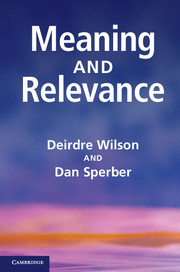Book contents
- Frontmatter
- Contents
- Figures
- Tables
- Preface
- Acknowledgements
- 1 Introduction
- Part I Relevance and Meaning
- 2 The mapping between the mental and the public lexicon
- 3 Truthfulness and relevance
- 4 Rhetoric and relevance
- 5 A deflationary account of metaphors
- 6 Explaining irony
- Part II Explicit and Implicit Communication
- Part III Cross-Disciplinary Themes
- Notes
- References
- Index
4 - Rhetoric and relevance
Published online by Cambridge University Press: 05 June 2012
- Frontmatter
- Contents
- Figures
- Tables
- Preface
- Acknowledgements
- 1 Introduction
- Part I Relevance and Meaning
- 2 The mapping between the mental and the public lexicon
- 3 Truthfulness and relevance
- 4 Rhetoric and relevance
- 5 A deflationary account of metaphors
- 6 Explaining irony
- Part II Explicit and Implicit Communication
- Part III Cross-Disciplinary Themes
- Notes
- References
- Index
Summary
A paradox and a dilemma
The student of rhetoric is faced with a paradox and a dilemma. We will suggest a solution to the dilemma, but this will only make the paradox more blatant.
Let us start with the paradox. Rhetoric took pride of place in formal education for two and a half millennia. Its very rich and complex history is worth detailed study, but it can be summarised in a few sentences. Essentially the same substance was passed on by eighty generations of teachers to eighty generations of pupils. If there was a general tendency, it consisted merely in a narrowing of the subject matter of rhetoric: one of its five branches, elocutio, the study of figures of speech, gradually displaced the others, and in some schools, became identified with rhetoric tout court. (We will also be guilty of this and several other simplifications.) The narrowing was not even offset by a corresponding increase in theoretical depth. Pierre Fontanier’s Les Figures du Discours is not a radical improvement on Quintilian’s Institutio Oratoria, despite the work of sixty generations of scholars in between.
- Type
- Chapter
- Information
- Meaning and Relevance , pp. 84 - 96Publisher: Cambridge University PressPrint publication year: 2012
- 4
- Cited by



